Charles E W Bean, Diaries, AWM38 3DRL 606/274/1 - 1918 - 1941 - Part 5
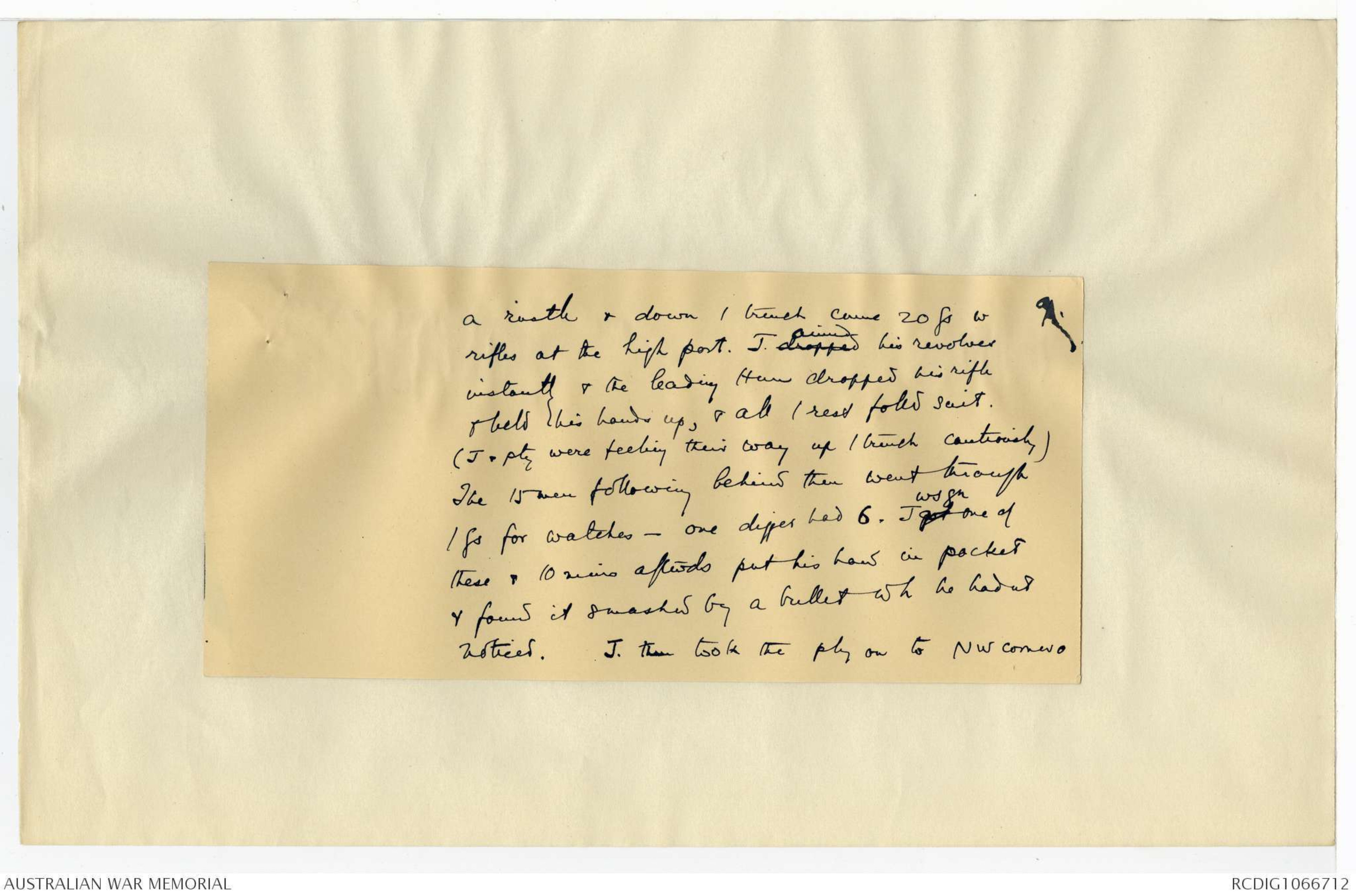
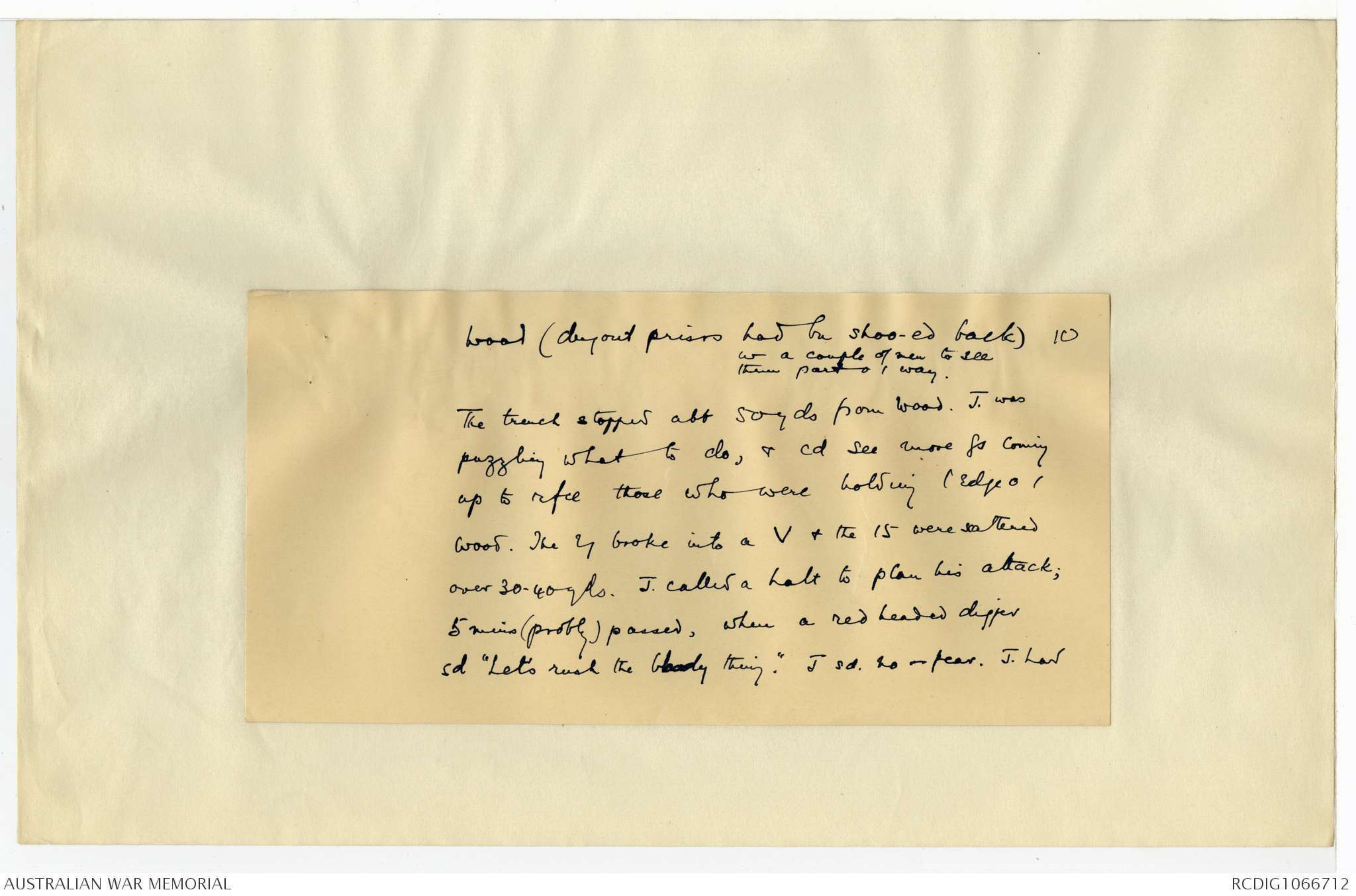
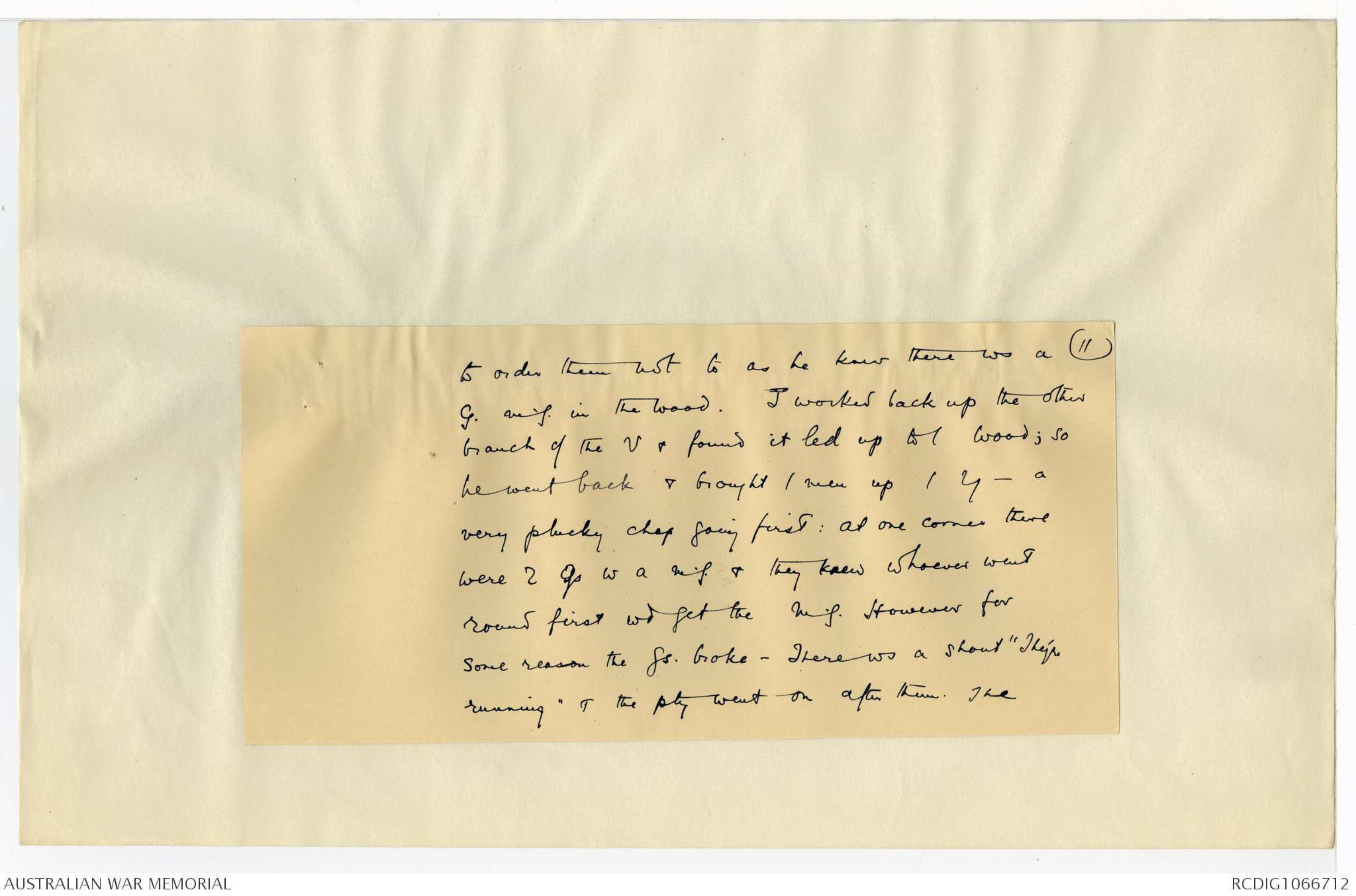
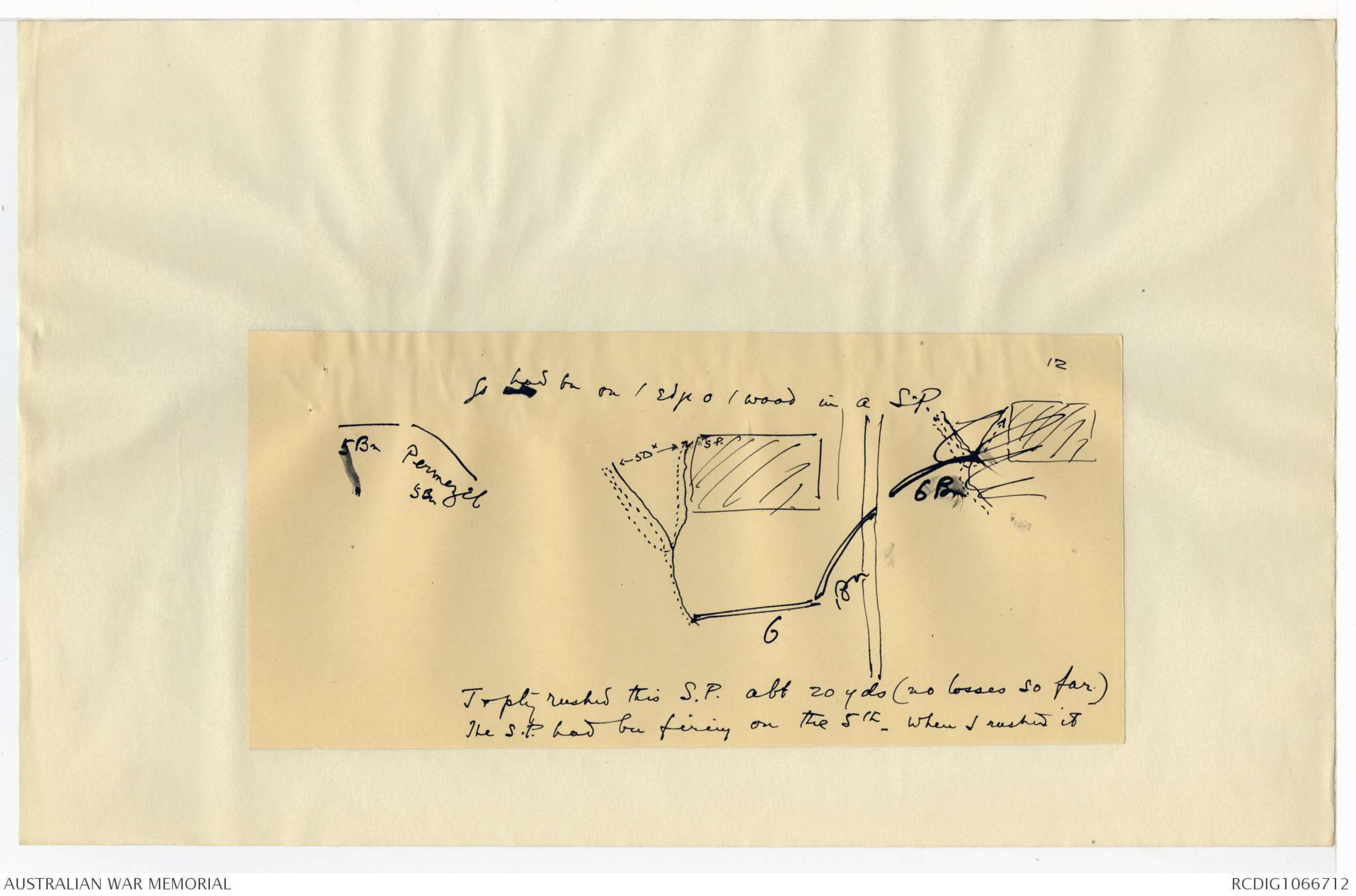
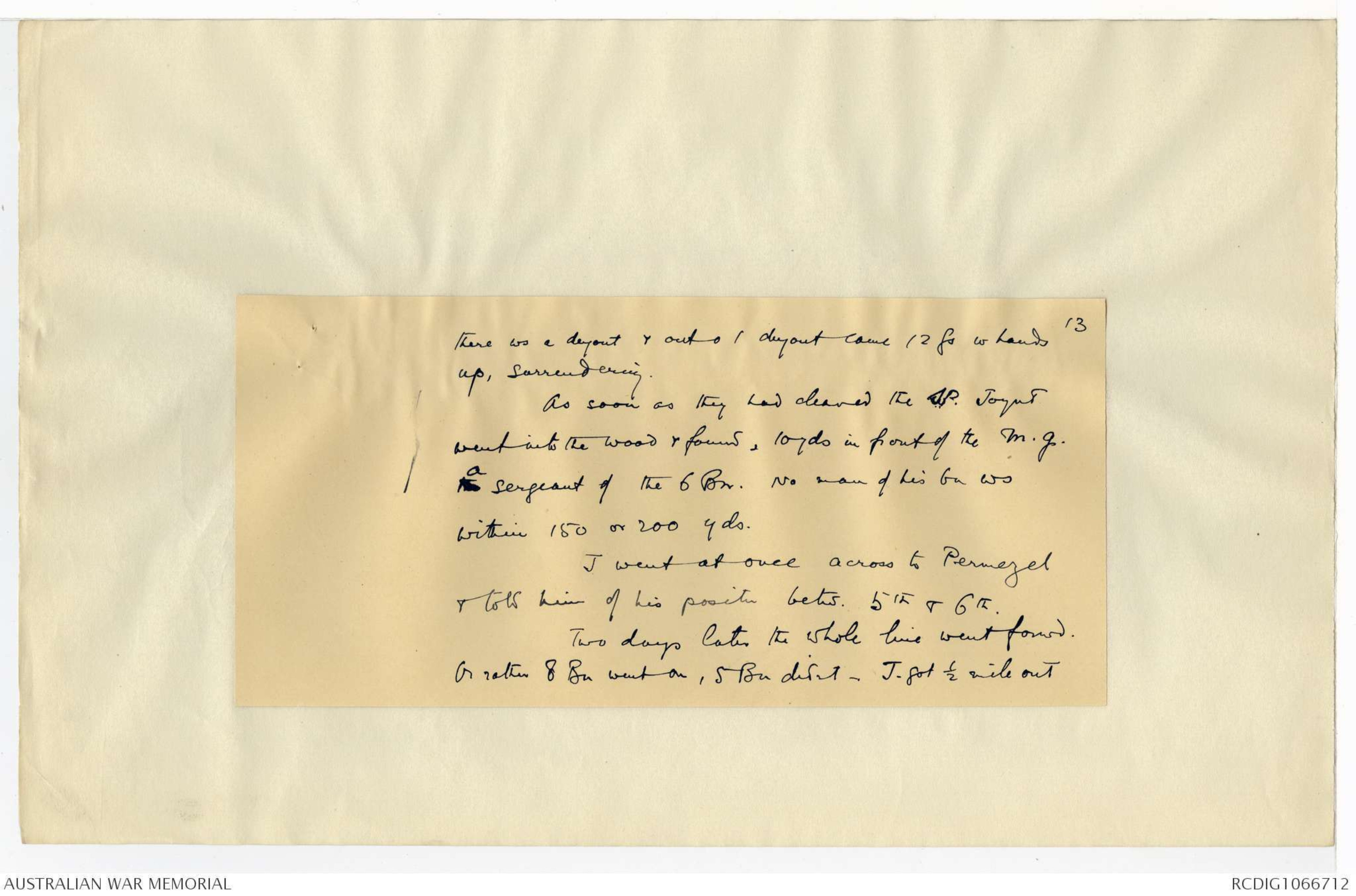
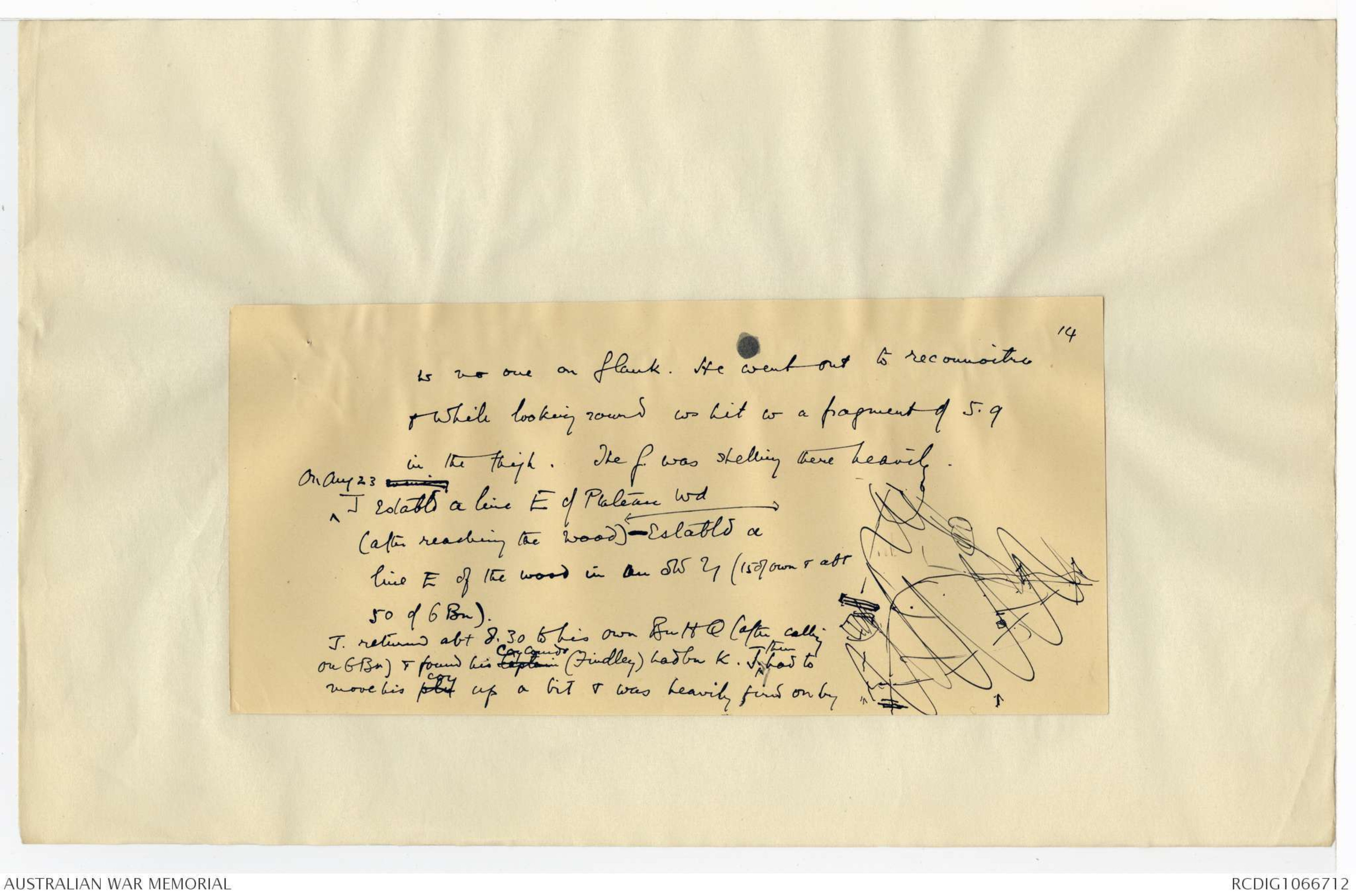

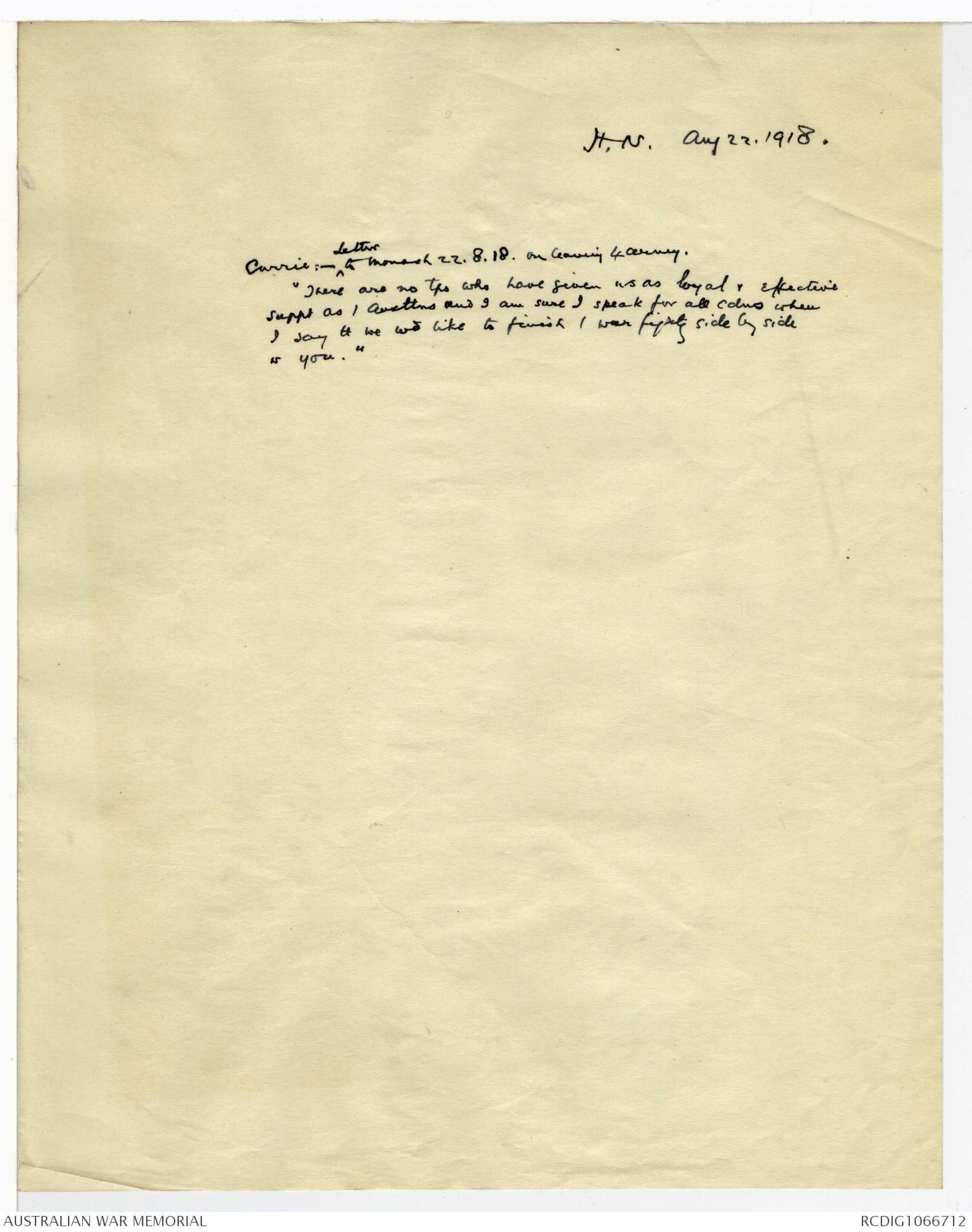
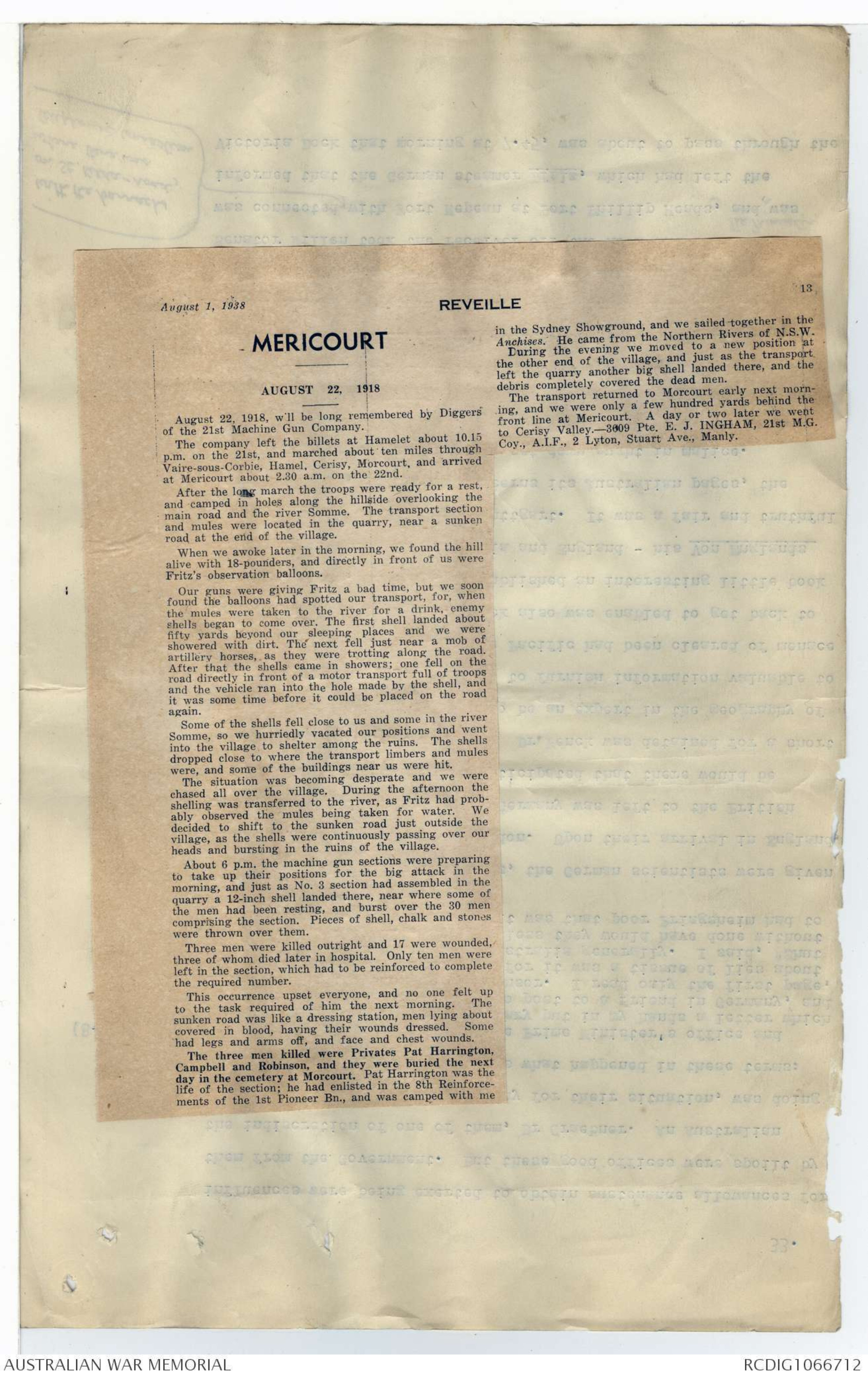
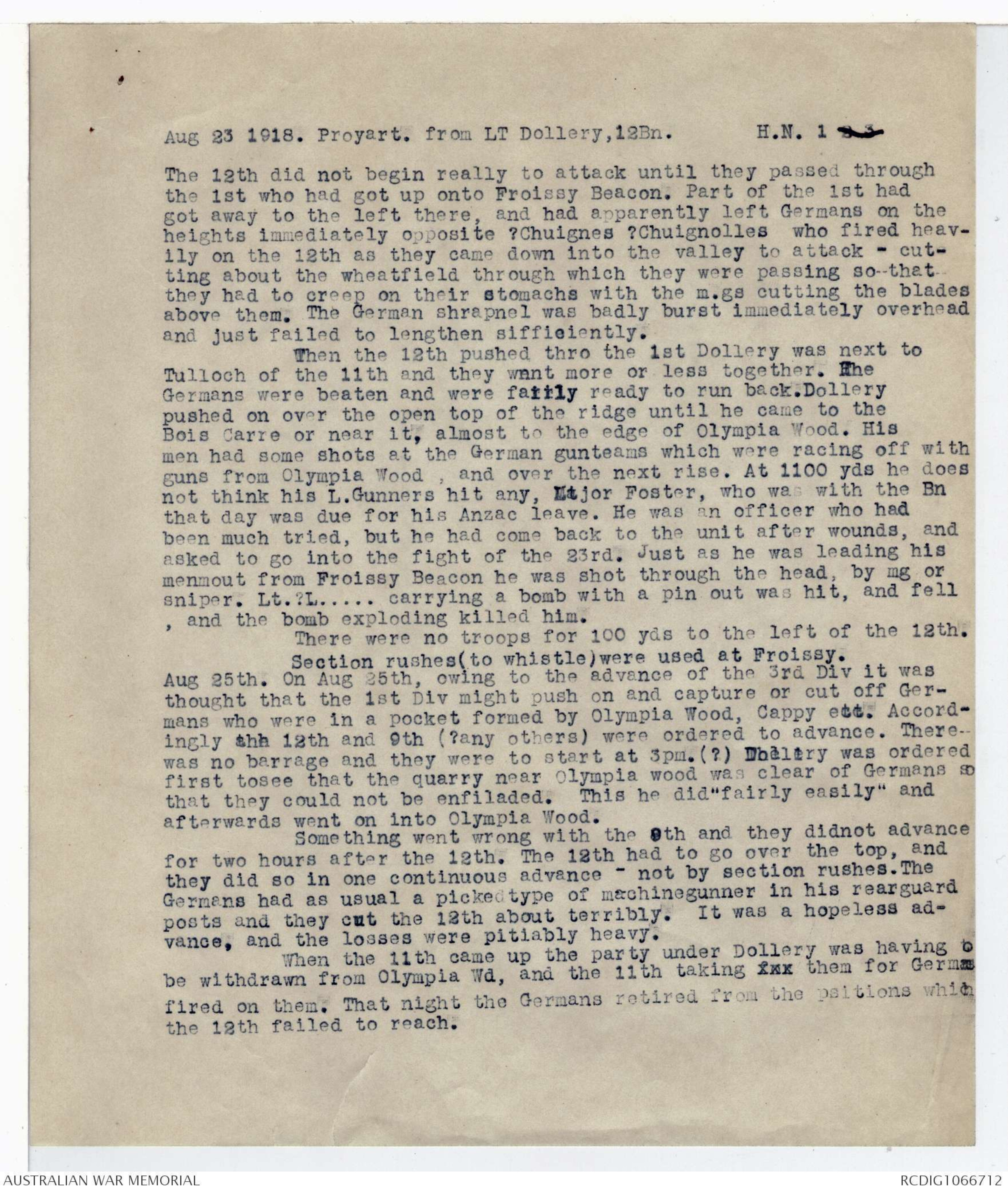
9.
a rustle & down / trench came 20 Gs w
rifles at the high port. J. dropped aimed his revolver
instantly & the leading Hun dropped his rifle
& held his hands up, & all / rest folld suit.
(J & pty were feeling their way up / trench cautiously)
The 15 men following behind then went through
/ Gs for watches - one digger had 6. J got ws gn one of
these & 10 mins aftwds put his hand in pocket
& found it smashed by a bullet wh he hadnt
noticed. J. then took the ply on to NW corner o
10
Wood (dugout prisrs had bn shoo-ed back)
w a couple of men to see
them part o / way.
The trench stopped abt 50 yds from wood. J. was
puzzling what to do, & cd see more Gs coming
up to refce those who were holding / edge o /
wood. The trench broke into a V & the 15 were scattered
over 30-40 yds. J. called a halt to plan his attack;
5 mins (probly) passed, when a red headed digger
sd "Let's rush the bloody thing." J sd no - fear. J had
11
to order them not to as he knew there ws a
G. m.g. in the wood. J worked back up the other
branch of the V & found it led up to / wood; so
he went back & brought / men up / trench - a
very plucky chap going first: at one corner there
were 2 Gs w a m.g. & they knew whoever went
round first wd get the m.g. However for
some reason the Gs. broke - There ws a shout "They're
running" & the pty went on after them. The
12
Gs xx had bn on / edge o / wood in a S.P.
Hand drawn diagram - see original document.
J & pty rushed this S.P. abt 20 yds (no losses so far)
The S.P. had bn firing on the 5th - when J rushed it
13
There ws a dugout & out o / dugout came 12 Gs w hands
up, surrendering.
As soon as they had cleared the S.P. Joynt
went into the wood & found, 10 yds in front of the m.g.
the A sergeant of the 6 Bn. No man of his bn ws
within 150 or 200 yds.
J went at once across to Permezel
& told him of his positn betw. 5th & 6th.
Two days later the whole line went Forwd
Or rather 8 Bn went on, 5 Bn didn't - J got ½ mile out
14
w no one on flank. He went out to reconnoitre
& while looking round ws hit w a fragment of 5.9
in the thigh. The G was shelling there heavily.
On Aug 23 evening J establd a line E of Plateau Wd
(after reaching the wood) - establd a
line E of the wood in an SW trench (15 of own & abt
50 of 6 BN).
J. returned abt 8.30 to his own Bn HQ (after calling
on 6 Bn) & found his Captain Commandr (Findley) had bn k. J then had to
move his ply coy up a bit & was heavily fired on by
[*Hand drawn diagram -see original document*]
15
Gs in Herleville Wood. A pty of some 200 Gs. being brought
in as prisrs by 3 or 4 Scots was here mercislessly fired
on by the G. m. guns & cut to bits.
J. took his coy farther back; & was then ordered
E of Plateau Wood (the posn wh he had captd,) w his Coy.
He remained there reporting to the C.O. of the 8th.
Two days later rest of 8 reld the 6th.
H.N. Aug 22.1918.
Carrie :- ^Letter to Monash 22.8.18. on leaving 4 ceremy.
"There are no tps who have given us as loyal & effective
suppt as / Austlns and I am sure I speak for all cdns when
I say tt we wd like to finish / war fighting side by side
w you."
August 1, 1938 REVEILLE 13
MERICOURT
AUGUST 22, 1918
August 22, 1918, will long be remembered by Diggers
of the 21st Machine Gun Company.
The company left the billets at Hamelet about 10.15
p.m. on the 21st, and marched about ten miles through
Vaire-sous-Corbie, Hamel, Cerisy, Morcourt, and arrived
at Mericourt about 2.30 a.m. on the 22nd.
After the long march the troops were ready for a rest,
and camped in holes along the hillside overlooking the
main road and the river Somme. The transport section
and mules were located in the quarry, near a sunken
road at the end of the village.
When we awoke later in the morning, we found the hill
alive with 18-+pounders, and directly in front of us were
Fritz's observation balloons.
Our guns were giving Fritz a bad time, but we soon
found the balloons had spotted our transport, for, when
the mules were taken to the river for a drink, enemy
shells began to come over. The first shell landed about
fifty yards beyond our sleeping places and we were
showered with dirt. The next fell just near a mob of
artillery horses, as they were trotting along the road.
After that the shells came in showers; one fell on the
road directly in front of a motor transport full of troops
and the vehicle ran into the hole made by the shell, and
it was some time before it could be placed on the road
again.
Some of the shells fell close to us and some in the river
Somme, so we hurriedly vacated our positions and went
into the village to shelter among the ruins. The shells
dropped close to where the transport limbers and mules
were, and some of the buildings near us were hit.
The situation was becoming desperate and we were
chased all over the village. During the afternoon the
shelling was transferred to the river, as Fritz had probably
observed the mules being taken for water. We
decided to shift to the sunken road just outside the
village, as the shells were continuously passing over our
heads and bursting in the ruins of the village.
About 6 p.m. the machine gun sections were preparing
to take up their positions for the big attack in the
morning, and just as No. 3 section had assembled in the
quarry a 12-inch shell landed there, near where some of
the men had been resting, and burst over the 30 men
comprising the section. Pieces of shell, chalk and stones
over them.
Three men were killed outright and 17 were wounded,
three of whom died later in hospital. Only ten men were
left in the section, which had to be reinforced to complete
the required number.
This occurrence upset everyone, and no one felt up
to the task required of him the next morning. The
sunken road was like a dressing station, men lying about
covered in blood, having their wounds dressed. Some
had legs and arms off, and face and chest wounds.
The three men killed were Privates Pat Harrington,
Campbell and Robinson, and they were buried the next
day in the cemetery at Morcourt. Pat Harrington was the
life of the section; he had enlisted in the 8th Reinforcements
of the 1st Pioneer Bn., and was camped with me
in the Sydney Showground, and we sailed together in the
Anchises. He came from the Northern Rivers of N.S.W.
During the evening we moved to a new position at
the other end of the village, and just as the transport
left the quarry another big shell landed there, and the
debris completely covered the dead men.
The transport returned to Morcourt early next morning
and we were only a few hundred yards behind the
front line at Mericourt. A day or two later we went
to Cerisy Valley. - 3609 Pte. E. J. INGHAM, 21st M.G.
Coy., A.I.F., 2 Lyton Stuart Ave., Manly.
Aug 23 1918. Proyart. from LT Dollery, 12Bn. H.N. 1 23
The 12th did not begin really to attack until they passed through
the 1st who had got up onto Froissy Beacon. Part of the 1st had
got away to the left there, and had apparently left Germans on the
heights immediately opposite ?Chuignes ?Chuignolles who fired heavily
on the 12th as they came down into the valley to attack - cutting
about the wheatfield through which they were passing so that
they had to creep on their stomachs with the m.gs cutting the blades
above them. The German shrapnel was badly burst immediately overhead
and just failed to lengthen sufficiently.
When the 12th pushed thro the 1st Dollery was next to
Tulloch of the 11th and they went more or less together. The
Germans were beaten and were fairly ready to run back. Dollery
pushed on over the open top of the ridge until he came to the
Bois Carre or near it, almost to the edge of Olympia Wood. His
men had some shots at the German gunteams which were racing off with
guns from Olympia Wood, and over the next rise. At 1100 yds he does
not think his L.Gunners hit any, Major Foster, who was with the Bn
that day was due for his Anzac leave. He was an officer who had
been much tried, but he had come back to the unit after wounds, and
asked to go into the fight of the 23rd. Just as he was leading his
men out from Froissy Beacon he was shot through the head, by mg or
sniper. Lt. ?L...... carrying a bomb with a pin out was hit, and fell,
and the bomb exploding killed him.
There were no troops for 100 yds to the left of the 12th.
Section rushes(to whistle) were used at Froissy.
Aug 25th. On Aug 25th, owing to the advance of the 3rd Div it was
thought that the 1st Div might push on and capture or cut off Germans
who were in a pocket formed by Olympia Wood, Cappy etc. Accordingly
the 12th and 9th (?any others) were ordered to advance. There
was no barrage and they were to start at 3 pm. (?) Dollery was ordered
first tosee that the quarry near Olympia wood was clear of Germans so
that they could not be enfiladed. This he did "fairly easily" and
afterwards went on into Olympia Wood.
Something went wrong with the 9th and they did not advance
for two hours after the 12th. The 12th had to go over the top, and
they did so in one continuous advance - not by section rushes. The
Germans had as usual a picked type of machine gunner in his rearguard
posts and they cut the 12th about terribly. It was a hopeless advance,
and the losses were pitiably heavy.
When the 11th came up the party under Dollery was having to
be withdrawn from Olympia Wd, and the 11th taking for them for Germans
fired on them. That night the Germans retired from the positions which
the 12th failed to reach.
 Sam scott
Sam scottThis transcription item is now locked to you for editing. To release the lock either Save your changes or Cancel.
This lock will be automatically released after 60 minutes of inactivity.